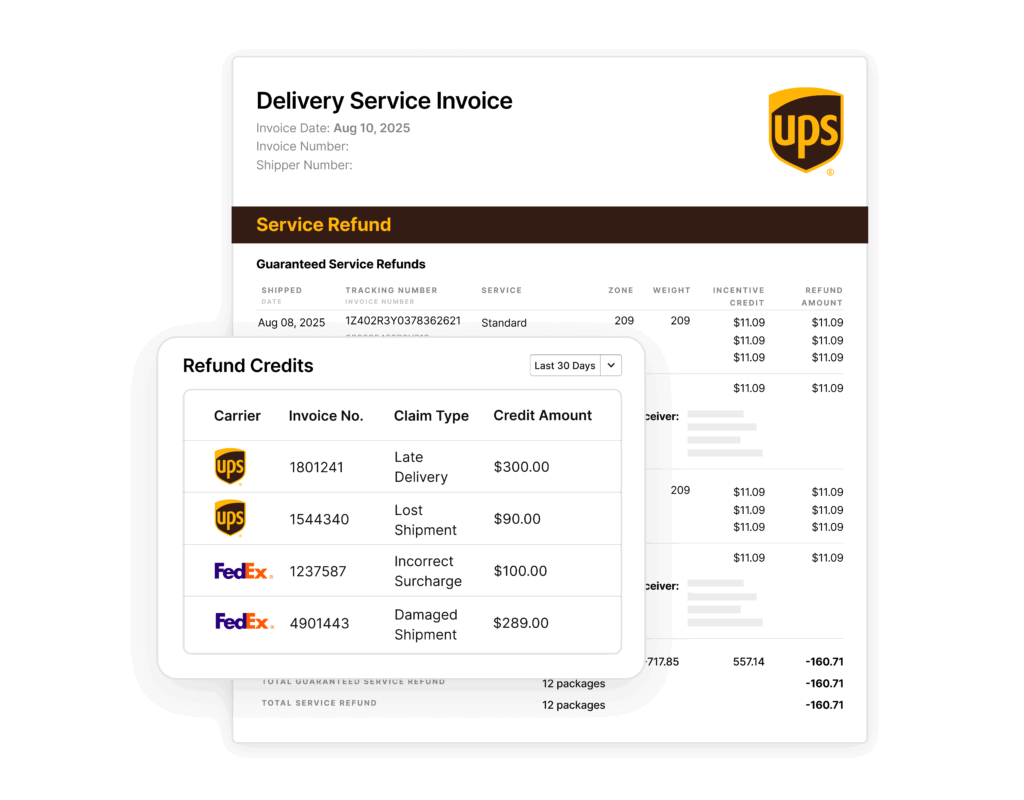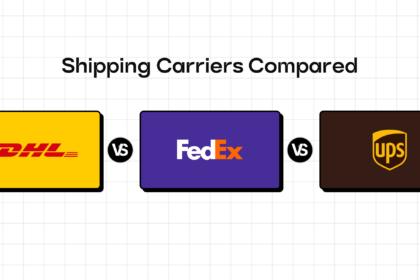Here’s the thing about shipping costs: they’re quietly bleeding your business dry. Most companies treat them like a fixed expense, but what if I told you that 5-20% of every shipping dollar you spend is getting lost to errors you never even notice?
Parcel auditing is the process of systematically reviewing shipping invoices and carrier performance to catch billing mistakes and claim refunds for service failures. It sounds mundane, but it’s one of the highest-ROI activities any shipping business can implement.
Parcel auditing is an important aspect in the shipping and logistics of your e-commerce or 3PL business, as it not only guarantees savings of shipping costs but also ensures accuracy and optimization in existing practices.
Why Your Business Is Probably Overpaying?
Carrier invoices are incredibly complex. Between fuel surcharges, dimensional weight calculations, residential delivery fees, and zone classifications, there are dozens of ways for errors to creep in. And carriers aren’t exactly incentivized to find mistakes in your favor.
Let’s break down what this really means. UK carriers achieved a 92.9% first-time delivery success rate in 2025. That sounds pretty good until you realize nearly 7% of parcels are delayed or misdelivered. For businesses shipping thousands of parcels monthly, that’s a massive leak in both money and customer trust.
The financial impact is straightforward: most companies that audit consistently recover 5-20% of their shipping spend. But the operational benefits run deeper. Audits expose patterns like recurring delays in specific zones or repeated billing errors that you can address upstream with your carriers.
There’s also the customer experience angle that most people miss. When you catch service failures and get refunds, you can resolve customer complaints faster. Fewer “Where is my order?” tickets, happier customers, better reviews.
Three Ways to Audit Your Shipping
Not every business should audit the same way. Your approach depends on volume, resources, and complexity:
- Manual Parcel Auditing
- Outsourced Services
- Software-assisted Auditing
Manual Parcel Auditing
Manual auditing means someone on your team reviews invoices line by line, cross-references tracking data, and files claims directly with carriers. This might work if you’re shipping fewer than 500 parcels per month but can be extremely time-intensive and prone to human error as it doesn’t scale as volume grows.
Outsourced Services
You hand off your invoices to a third-party auditing firm that manages the entire process, from error identification to claim filing and recovery. While it is great for scaling with volume, there Less control over the process due to limited visibility into what’s being audited. While there’s also the potentially higher fees.
Software-assisted Auditing
Automated parcel audit software scans your invoices, identifies discrepancies, and files claims on your behalf—while keeping you in control of the process and data. An automated solution scales effortlessly with volume and gives you real-time insights and reporting, so that you gain full visibility over your parcel performance. This usuaully involves a subscription or performance-based fee but that is worth it, given the savings you might make.

How Parcel Auditing Actually Works
The process follows a straightforward workflow that most businesses can implement:
First, you gather all the data. This means pulling carrier invoices, your shipping contracts, and transaction records from whatever systems you use. Sometimes it’s clean EDI feeds, sometimes it’s messy PDFs and spreadsheets.
Next comes the comparison phase. You’re looking for discrepancies between what you were billed and what your contract says you should pay. Common issues include late deliveries, duplicate charges, miscalculated dimensional weights, and missed contracted discounts.
Then you submit claims. Here’s where timing matters. UPS gives you 180 days to file claims, but FedEx requires you to submit them within 15 days. USPS deadlines vary by service type. Miss these windows and you’ve lost money permanently.
Carriers typically issue refunds as credits on future invoices, though some will adjust open bills directly. The key is tracking these refunds to ensure they actually appear.
The final step is trend analysis. If you’re seeing repeated dimensional weight miscalculations or consistent delays in certain ZIP codes, that’s valuable leverage for future carrier negotiations.
The Errors Hiding in Plain Sight
Parcel invoices hide dozens of potential mistakes. The most common ones include duplicate billing, late delivery charges you shouldn’t pay, incorrect surcharges, dimensional weight miscalculations, address correction fees, zone misclassifications, and missed contracted discounts.
Here’s a real example: a mid-sized apparel brand started auditing their shipments and discovered they were being systematically overcharged for dimensional weight calculations. After implementing regular audits, they cut their monthly shipping spend by 12%.
The beauty is that catching even a few of these errors each billing cycle compounds into substantial yearly savings.
Beyond Refunds: The Strategic Value
Parcel auditing delivers direct refunds, but the indirect benefits might be more valuable. When you have hard data about carrier performance, you negotiate from a position of strength.
Let’s say you’re renewing your FedEx contract. Instead of accepting their standard rates, you can show them exactly where they missed service commitments and demand better terms. One electronics retailer used audit insights to secure a 10% cost reduction on peak season shipments. Without concrete performance data, such negotiations rarely succeed.
The typical recovery rate sits around 5-7% of monthly spend, but at enterprise scale, this translates to six-figure annual savings. More importantly, you’re building a foundation for better carrier relationships and stronger contracts.
The Technology Revolution

The future of parcel auditing is fully automated. AI-driven platforms now detect suspicious charges or billing mismatches in seconds. Automated claim filing eliminates the administrative burden and speeds up refunds, while predictive analytics can even forecast potential issues before they occur.
This is where LateShipment.com sets the benchmark. Our platform is powered by machine learning trained on 220+ million parcel transactions, enabling unmatched accuracy in spotting errors that manual audits or generic tools miss. Beyond refunds, LateShipment.com integrates financial, operational, and customer experience data into a single dashboard, giving businesses complete visibility into shipping performance and costs.
The result? Audits that are faster, smarter, and more reliable—helping retailers recover lost dollars, negotiate stronger contracts, and deliver better customer experiences.
The Customer Experience Connection
Most people think of parcel auditing as a finance function, but here’s what they’re missing: every refund tells a bigger story about your customer experience.
That late delivery refund you recovered? It represents a frustrated customer who’s questioning whether they can trust your brand. The $15 you get back from the carrier doesn’t offset the potential $1,500 in lifetime value you lose when that shopper decides to try a competitor instead. Research shows 92% of customers will switch after a poor delivery experience.
What this really means is that auditing needs to go beyond just recovering money. You need to dig into the patterns behind delivery failures and understand their real impact on customer relationships. Are certain ZIP codes consistently problematic? Is one carrier consistently missing delivery windows during peak seasons?
The businesses that get this right don’t just use auditing for cost recovery. They use it to safeguard customer trust and prevent churn. When you can spot and fix process breakdowns before they become customer complaints, that’s when parcel auditing becomes a competitive advantage.
Getting Started
If you’re shipping more than 500 parcels monthly and not auditing, you’re leaving money on the table. Start with whatever method fits your resources, but start somewhere. The errors are there whether you’re looking for them or not.
Parcel auditing in 2025 isn’t just about finding billing mistakes. It’s about building resilience into your logistics operations and protecting your customer relationships. With shipping costs rising and carrier surcharges multiplying, businesses that audit consistently gain a real competitive advantage in both profitability and customer trust.
Strategies to Overcome These Challenges
So, how can you overcome these challenges and make your parcel auditing process smoother? Here are five strategies:
Parcel Audit Software
As mentioned earlier, parcel audit software can be a huge help. It automates many of the tasks that can be prone to errors when done manually, like checking for duplicate invoices or making sure the rates are correct. This frees up your team to focus on other important tasks.
Parcel audit software can analyze your shipping data to identify areas where you might be overspending. For example, it can help you spot inconsistencies in how your carriers are applying discounts or identify instances where you’re being charged for services you didn’t actually use. This kind of detailed analysis can be incredibly valuable in helping you understand your true shipping costs and find opportunities to save money.
Parcel audit software can also help you track your carrier’s performance over time. This includes things like on-time delivery rates, the frequency of damaged shipments, and how quickly they respond to claims. Having this information is helpful when it comes to negotiating better rates with your carriers or deciding whether to switch to a different provider.
Blue-Box Opportunity
How to Choose the Right Parcel Auditing Software?
To select the right parcel auditing software for your business, consider the following:
- Does the software integrate with all of your current shipping carriers?
- What is the provider’s customer service process like?
- Does the software offer comprehensive reporting and analytics on shipping data?
- What is the pricing structure, and does it align with your budget and shipping volume?
Still wondering which parcel auditing solution to choose? Here’s our list of the best parcel auditing software.
Clear Contracts
Make sure your carrier contracts are clear and easy to understand. This will help avoid billing errors due to misinterpretations. If you’re not sure about something in a contract, don’t hesitate to ask for clarification.
Regular Communication
Keep the lines of communication open with your carriers. This can help you address any issues that arise quickly and efficiently. For example, if you notice a recurring error on your invoices, reach out to your carrier to discuss it and find a solution.
Data-Driven Decisions
Use the data you gather from your audits to make better decisions about your shipping processes. For example, if you notice that a particular carrier is consistently late with deliveries, you might consider switching to a different carrier. Or, if you see that you’re often being charged for address corrections, you might need to improve your address validation process.
Effective Parcel Auditing with LateShipment.com
Parcel auditing is an invaluable process that helps you identify areas where you are overspending on shopping. Manual parcel auditing can be quite tedious and time-consuming. Parcel auditing software, on the other hand, automates this entire process to quickly and accurately identify areas for savings.
When it comes to software solutions, Lateshipment.com offers a comprehensive Parcel Audit and Shipping Refunds tool that delivers all the features you need to effortlessly recover shipping costs for more than 50 service failures and billing errors. LateShipment.com automatically audits your shipping invoices, runs 160+ point checks, automatically submits refund claims, and has a team of experts to help navigate claim redressals.
With LateShipment.com, you get a platform that easily integrates with your existing tech stack without necessitating a complete overhaul. It also brings you features like Delivery Experience Management and Returns Experience Management to further elevate the customer experience, foster loyalty and strengthen your brand reputation.
Take control of your shipping costs today! Book a demo to explore the benefits of Lateshipment.com’s parcel auditing solutions.
Frequently Asked Questions about Parcel Audits
What is a parcel audit?
A parcel audit is the process of reviewing your carrier invoices to identify billing errors, incorrect surcharges, service failures, and other discrepancies. It ensures you’re only paying for what you actually used and that carriers are honoring their service commitments.
Why do I need to audit my shipping invoices?
Carrier billing errors are more common than you think. Studies show that 10–20% of shipping invoices contain mistakes—from incorrect dimensional weight charges to duplicate billing to unauthorized surcharges. Without auditing, you’re leaving money on the table.
What’s the difference between manual and automated parcel auditing?
Manual auditing requires someone on your team to comb through invoices line by line, cross-reference tracking data, and file claims with carriers. It’s time-consuming, error-prone, and doesn’t scale. On the other hand, Automated auditing uses software to scan every invoice, flag discrepancies in real time, and file claims on your behalf. It’s faster, more accurate, and catches errors manual reviews miss.
What happens during peak season when money-back guarantees are suspended?
Late delivery refunds may be paused, but that doesn’t mean savings stop. You can still recover charges for Incorrect surcharges, DIM weight errors, Duplicate charges, etc,.
How do I get started with parcel auditing?
Start by reviewing a sample of recent invoices to understand your baseline error rate. You can do a free audit of your shipping invoices to see every instance you are entitled to receive a refund for.











